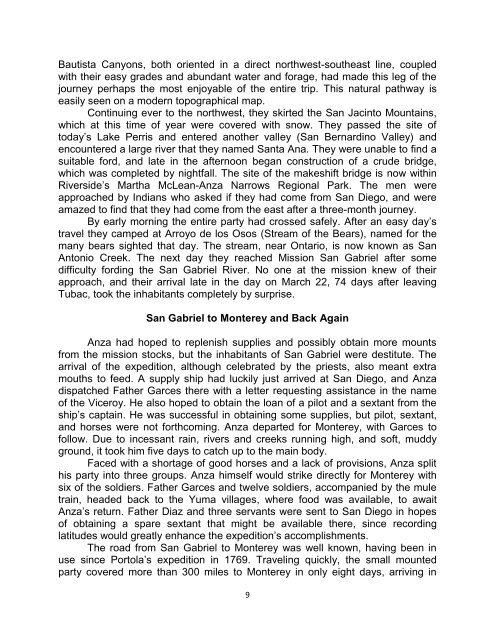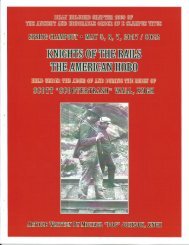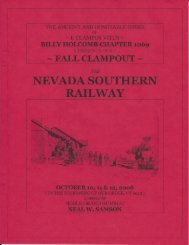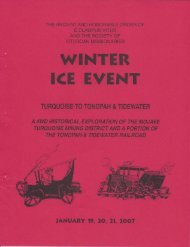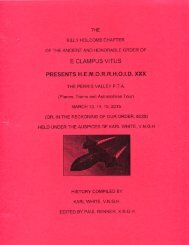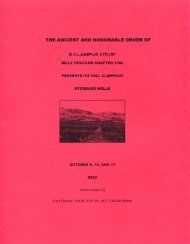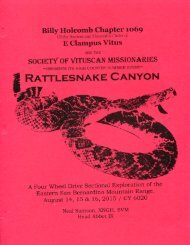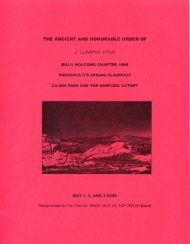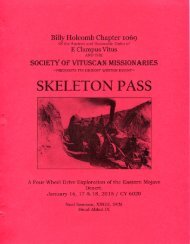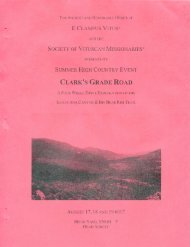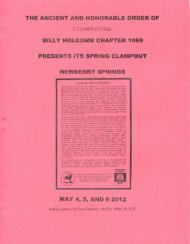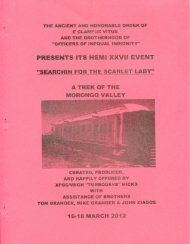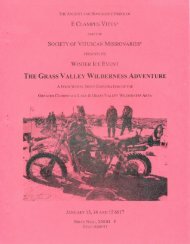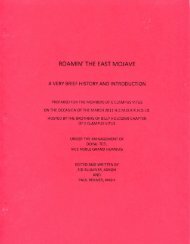6023 Spring Doins ANZA EXPEDITIONS History
Create successful ePaper yourself
Turn your PDF publications into a flip-book with our unique Google optimized e-Paper software.
Bautista Canyons, both oriented in a direct northwest-southeast line, coupled<br />
with their easy grades and abundant water and forage, had made this leg of the<br />
journey perhaps the most enjoyable of the entire trip. This natural pathway is<br />
easily seen on a modern topographical map.<br />
Continuing ever to the northwest, they skirted the San Jacinto Mountains,<br />
which at this time of year were covered with snow. They passed the site of<br />
today’s Lake Perris and entered another valley (San Bernardino Valley) and<br />
encountered a large river that they named Santa Ana. They were unable to find a<br />
suitable ford, and late in the afternoon began construction of a crude bridge,<br />
which was completed by nightfall. The site of the makeshift bridge is now within<br />
Riverside’s Martha McLean-Anza Narrows Regional Park. The men were<br />
approached by Indians who asked if they had come from San Diego, and were<br />
amazed to find that they had come from the east after a three-month journey.<br />
By early morning the entire party had crossed safely. After an easy day’s<br />
travel they camped at Arroyo de los Osos (Stream of the Bears), named for the<br />
many bears sighted that day. The stream, near Ontario, is now known as San<br />
Antonio Creek. The next day they reached Mission San Gabriel after some<br />
difficulty fording the San Gabriel River. No one at the mission knew of their<br />
approach, and their arrival late in the day on March 22, 74 days after leaving<br />
Tubac, took the inhabitants completely by surprise.<br />
San Gabriel to Monterey and Back Again<br />
Anza had hoped to replenish supplies and possibly obtain more mounts<br />
from the mission stocks, but the inhabitants of San Gabriel were destitute. The<br />
arrival of the expedition, although celebrated by the priests, also meant extra<br />
mouths to feed. A supply ship had luckily just arrived at San Diego, and Anza<br />
dispatched Father Garces there with a letter requesting assistance in the name<br />
of the Viceroy. He also hoped to obtain the loan of a pilot and a sextant from the<br />
ship’s captain. He was successful in obtaining some supplies, but pilot, sextant,<br />
and horses were not forthcoming. Anza departed for Monterey, with Garces to<br />
follow. Due to incessant rain, rivers and creeks running high, and soft, muddy<br />
ground, it took him five days to catch up to the main body.<br />
Faced with a shortage of good horses and a lack of provisions, Anza split<br />
his party into three groups. Anza himself would strike directly for Monterey with<br />
six of the soldiers. Father Garces and twelve soldiers, accompanied by the mule<br />
train, headed back to the Yuma villages, where food was available, to await<br />
Anza’s return. Father Diaz and three servants were sent to San Diego in hopes<br />
of obtaining a spare sextant that might be available there, since recording<br />
latitudes would greatly enhance the expedition’s accomplishments.<br />
The road from San Gabriel to Monterey was well known, having been in<br />
use since Portola’s expedition in 1769. Traveling quickly, the small mounted<br />
party covered more than 300 miles to Monterey in only eight days, arriving in<br />
9


